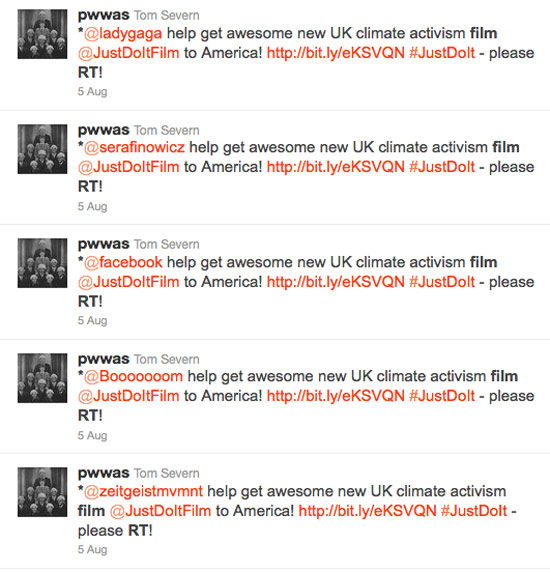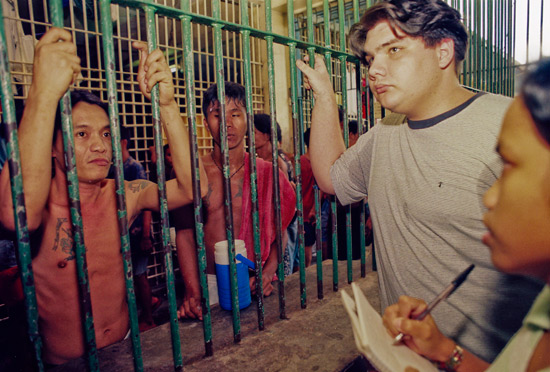I think you know how enthusiastic I am about all the tools and services out there to get our work done and share it with the community. We have moved from the Era of How to one of How To Do It Well. It is time to truly develop best practices.
Luckily this blog has become a bit of a platform for the community to share what we’ve learned. We are recognizing that we can build something better together. Today, filmmaker John T. Trigonis shares what he’s learned marrying Twitter to his IndieGoGo crowdfunding campaign.
Perhaps the most time-consuming part of any crowdfunding campaign is getting the word out about your project. Fortunately, we’re lucky to live during a time that’s made promotion as easy as sending an email or updating your Facebook status.
Twitter, in particular, has become a powerful force in the universe of marketing your campaign because of its real time nature. The challenge, however, is to keep from succumbing to the dark side of promotion––Spamotion.
Here are a few tips that I’ve learned through my own experiences crowdfunding my short film Cerise and by keeping a keen eye on other IndieGoGo campaigns.
Twitter Tip #1: Be a Prologue Before a Petition
IndieGoGo co-founder Slava Rubin says it best: “The world is shifting from a world of transactions to a world of relationships.” That said, it’s probably not the best idea to jump into promoting your campaign on Twitter if you don’t already have a strong following.
I joined Twitter on May 4th, 2009. I began crowdfunding for Cerise on February 2nd, 2010, nine months after I had birthed a modest following. The first people I followed were friends, of course. Then I started searching hashtags (#film and #filmmaking, for example) and following handles like @grking and @kingisafink––people who shared similar interests. Before long, I was engaging in meaningful 140-character conversations about obscure directors like Jodorowsky and sharing my insights on filmmaking with those who followed my tweets.
It would later be these same followers who would make up my core of initial funders for Cerise. But had I not given myself ample time to genuinely get to know them, to forge actual relationships instead of networks, I would have come across as a spam artist once my campaign had begun.
Twitter Tip #2: Creativity is King
It’s important to be creative when phrasing your tweets. It takes a little more time, but your followers will appreciate it since they’ll see that you’re not a @CampaignBot but an actual person who painstakingly crafts each and every promotional tweet as a affirmation of the passion he or she feels for it.

This is a pretty standard, run-of-the-mill tweet.

This tweet, however, shows a bit more pizazz and character!
But even a fun, quirky tweet like @Tearsinrain78 and @grahaminman’s will lose its charm if you see it three times in a row. Linking your personal Twitter account with your project’s can be detrimental to your crowdfunding efforts. Chances are the majority of your followers are also following your project, so if your accounts are linked, your tweets will quickly become redundant. Put in that extra effort and make every tweet from every account something special and worth reading.
Twitter Tip #3: Always Include Your (Shortened) Link
When tweeting about your campaign, always include a link to its home page so that the first thing a potential funder sees after they click the link is your pitch video.
And because every letter and space is precious on Twitter, you should always use a link shortener like Bit.ly or Ow.ly. I use Bit.ly the most because aside from its tracking capabilities, the site also allows users to customize their links, so your link could read bit.ly/TaoCF, which will bring you to my first Tao of Crowdfunding post “Three Ps for a Successful Film Campaign.” This way, it’s easy to remember while on the go and when using a mobile Twitter client.
Another favorite of mine is Hootsuite’s Hootlet, which allows users to shrink and share a link from a page they’re currently viewing. The Google Chrome-based web browser RockMelt has similar features for maximizing your social media output, though for now it’s a close third for me since it’s still in its most primitive beta stages.
Twitter Tip #4: #Hashtag #Everything #Relevant to your #Project
In every tweet you send, be sure to hashtag words and phrases related to your project and campaign. This makes it easy for random people to find your project on Twitter or through a Google search.
One thing you’ll want to do is find out what words or phrases bring specific communities together on Twitter. They’re sort of like little galaxies in a vast cosmos. For instance, if you’re making a movie, I’ve found that #film, #indiefilm and #filmmaking are popular hashtags for connecting to these communities.

Right away I know that this is a romantically comedic film based in Oregon.
If you’re working on a #vampire #film that’s got elements of #filmnoir and #comedy, then you’re quadrupling your outreach into the seemingly endless depths of the Twitterverse.
Twitter Tip #5: Remember––Don’t Solicit, Elicit
I introduced this nifty slogan in my previous blog post “A Practical Guide to Crowdfunder Etiquette” and it’s here as well because it’s doubly true when using Twitter.
Asking people to visit your IndieGoGo page will only get you so far in your campaign, but if your aim is to raise upwards of $15,000, you’ll need to expand your network and start eliciting responses from potential funders and supporters.
So what’s the difference between soliciting and eliciting? Well, here’s an example of a tweet that solicits, or asks, for help:

Now there’s nothing wrong with a tweet like this, of course; it’s very similar to the “Make it happen for (fill in your campaign here)” tweet we saw at earlier. But look at this example of a tweet that elicits, or evokes a response:

Obviously, this tweet for finishing funds for the film Jenny is meant to intrigue and make you want to click the link to see just what this campaign is all about.
Twitter Tip #6: People Need Their Space
Some people (myself included) still prefer to append their own messages before an “RT” and as much of your original message as possible. However, if by the time you click “Send” your character count is at zero, you risk possibly losing a personalized retweet that could elicit funds from other people’s followers.
The retweet button can seem a bit cold a way of spreading the word about your campaign, especially if the person doing the retweeting feels strongly about your project. A well-crafted tweet is no accident, but remember to keep it short and simple and leave at least 15 characters available for that super passionate backer to RT with ease.
Twitter Tip #7: @Everybody
Whenever you thank a contributor, be sure to mention (@) that person on Twitter. If you’re not sure if they have a Twitter account or don’t know that person’s handle, do a quick Google search of that person’s name and “on Twitter” and you’ll find him or her fairly easy.

The crowdfunders behind Jenny are thanking by name and by Twitter handle.
Even if they don’t use Twitter much or if their little pastel egg of a profile picture hasn’t hatched into the person you know and follow, show your appreciation anyway so it’s on the record, transparent and in plain site of everyone.
Bonus Tip: Avoid “The Flood” at All Costs!
Charlie Chaplin said it best in his famous speech at the end of The Great Dictator: “You are not machines, you are men” (and women!) That said, do not flood your feed with tweets exclusively about your campaign.

This example speaks a thousand words.
While crowdfunding is a full-time job and you should maintain a steady presence on Twitter while you’re campaigning, you should still be interacting with your followers in ways unrelated to your #Project. Remember, people give to people, not @bots. Once you nurture and maintain those relationships as a person more than a campaigner, you build a network that will walk beside a person they’ll forever be proud to know and support.
At the end of the day, it’s really all about personalization. That’s the most important thing to walk away from after reading this Tao of Crowdfunding blog post aside from a handful of helpful Twitter tips that will make your campaign a bit more approachable and more likely to reach its IndieGoGoal.











